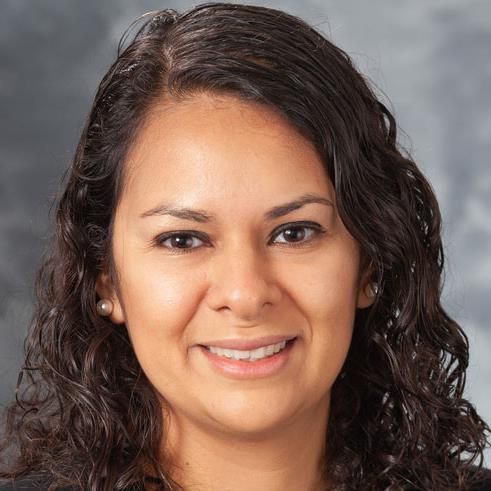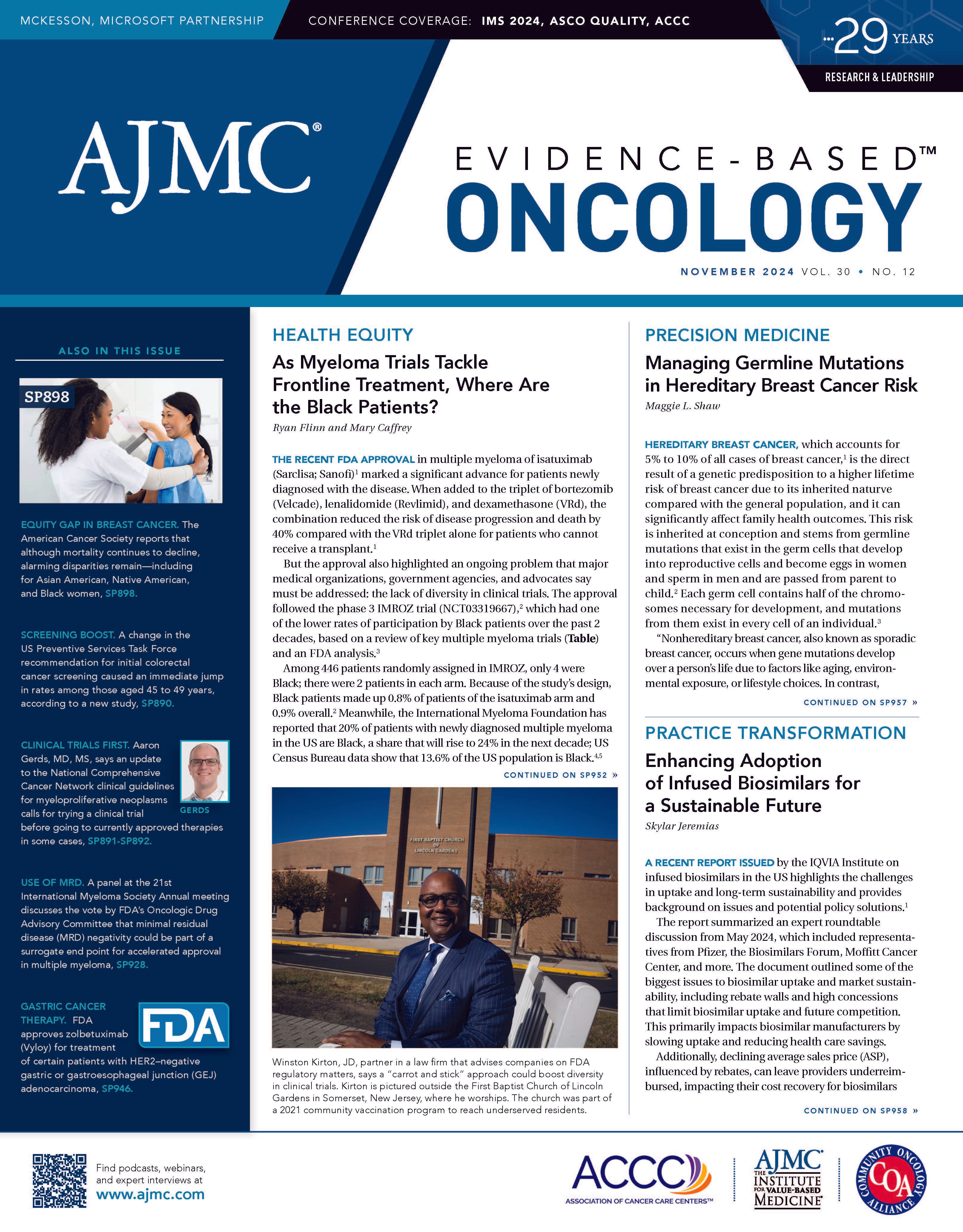- Center on Health Equity & Access
- Clinical
- Health Care Cost
- Health Care Delivery
- Insurance
- Policy
- Technology
- Value-Based Care
Advancing Equitable Access to Elevate Value-Based Cancer Care
Coverage from the IVBM Regional event in Boston, Massachusetts.
The first regional event of Institute for Value-Based Medicine,® {IVBM), held in Boston, Massachusetts, in September 2024, brought together top minds from the top cancer centers in Massachusetts and Connecticut to examine the fine line between wanting to take value-based cancer care to the next level and considering how to bring advancements in precision medicine and targeted treatment to patients who not only need them but meet criteria to receive them.

It was the first time an IVBM event was held in Boston, and the theme was “Elevating Value in Cancer Care.” The faculty examined top-of-mind issues in oncology: immunotherapy advancements in non–small cell lung cancer (NSCLC), targeting HER2 in breast cancer, identifying predictive biomarkers for sarcomas, and pharmacy decision-making in value-based oncology care.
Discussions highlighted the challenges of delivering immunotherapy across diverse practice environments, including issues with inpatient testing, treatment delays, and financial pressures related to molecular testing. Faculty emphasized the importance of integrating advanced biomarker approaches and optimizing dosing and duration rather than relying solely on new drug combinations. They advocated for a more thoughtful, mechanistic understanding of immunotherapy, and they addressed practical barriers to comprehensive biomarker testing, such as patient access, or lack thereof, and cost-effectiveness.
NSCLC: Optimizing Immunotherapy
Lynette Sholl, MD | Image: Brigham & Women's

Lynette M. Sholl, MD, chief of thoracic pathology at Brigham and Women’s Hospital and an associate professor of pathology at Harvard Medical School in Boston, moderated the panel discussion that explored the evolution and challenges of immunotherapy in NSCLC. She was joined by Karl J. D’Silva, MD, a hematologist/oncologist at Beth Israel Lahey Health in Peabody, Massachusetts; Narjust Florez, MD, associate director of the Cancer Care Equity Program at Dana-Farber Cancer Institute in Boston; Deepa Rangachari, MD, a medical oncologist at Beth Israel Deaconess Medical Center in Boston; and Umit Tapan, MD, a thoracic oncologist at Boston Medical Center and assistant professor of medicine at Boston University’s Chobanian & Avedisian School of Medicine.
The first immunotherapy used to treat NSCLC in the second line was approved on March 4, 2015, when the FDA approved nivolumab for patients whose advanced NSCLC had progressed during or after platinum-based chemotherapy.1 Since then, against a landscape of significant transformation and an evolving understanding that NSCLC is not just one disease but many,2 immunotherapy has become a standard-of-care regimen for patients who lack otherwise targetable mutations. However, despite its effectiveness, access to immunotherapy remains a challenge due to high cost, low availability, lack of a comprehensive understanding of how to optimize these treatments, and difficulties with postdischarge care coordination, particularly in low-resource settings, Sholl noted.
“Nine years in, we still have a lot to figure out about how the drugs even work and how to optimally leverage them in the patients [for whom] they may work,” Rangachari explained, “let alone the patients [for whom] we are not sure if they will work or why they do not work and what biomarkers to use to more optimally select.” A best practice is to start by rethinking how immunotherapy drugs are administered, she continued, “because these drugs are completely unlike cytotoxic chemotherapy agents. You administer the drugs, they kill the cells, and the patient [urinates] it out.”
Different dosing schemes are a potential solution, she emphasized, including de-escalating therapy, or even escalating therapy, such as that being investigated in the phase 3 INSIGNA trial (NCT03793179): pembrolizumab (Keytruda) alone or plus chemotherapy in the first line and as maintenance.3 Another potential path to take is rendering lung cancer treatment with the same rigor by defining, assessing, and tracking responses, and then modulating therapy in accordance with those responses, similar to the way chronic myelogenous leukemia is tracked, Rangachari said. “It’s important that we take the time to deeply understand the mechanisms of action and optimize the use of these drugs,” she said.
Narjust Florez, MD | Image: Dana-Farber

Added Florez, “The situation with immunotherapy is 2 things. First, yes, it is approved, but it’s not available everywhere, and there are differences in costs between the agents. So, what can we do all together to make sure everybody has access? This is a significant challenge, having high costs and limited availability, so we need to better understand how immunotherapy drugs work, their mechanisms of action, and their optimal use.”
Instead of adding new agents to current immunotherapy regimens “without a clear rationale,” clinical trials need to explore ways to potentiate and reactivate patients’ immune responses with optimal dosing, for example, rather than focusing solely on new combinations. The advancement of immunotherapy needs to be done more thoughtfully, she underscored.
“We need to stop and understand the cost, try to understand the mechanism. We continue to pile on drugs, to conduct multimillion [dollar] trials that don’t move forward. We spend money that can be used to create equity to ensure that other areas in the world have access to these miracle drugs,” Florez said. “It is a privilege to have immunotherapy, and we need to start by acknowledging that.”
Tapan noted that disparities in lung cancer treatment actually start at screening. “We know that lung cancer screening is low globally and in the US for every eligible patient,” he said. “But this number is significantly lower for Black vs White individuals.” Primary reasons for this, he continued, are that molecular testing and next-generation sequencing (NGS) are not part of standard-of-care treatment, and there is a hefty price tag. “So, although immunotherapy has revolutionized lung cancer care, if we cannot use it, it’s not going to work,” he said.
Tapan also pointed to the challenges inherent in receiving a diagnosis of NSCLS as an inpatient. This can lead to difficulty obtaining the necessary NGS and starting treatment because inpatient policies and insurance restrictions frequently create roadblocks to initiating immunotherapy during a hospital stay, which carries over into treatment delays and greater chances of hospital readmission. Two trials are evaluating ways to open up treatment pathways and improve treatment planning and outcomes: Pragmatica-Lung has minimal exclusion criteria (phase 3; NCT05633602),4 and the LEADER trial allows all patients with resectable disease to undergo biomarker testing (observational; NCT04712877).5
D’Silva concurred with the other panelists, noting that a primary focus needs to be on defining which patients definitely will benefit. Lahey Health has implemented an algorithm to ensure all patients who have lung cancer receive in-house testing for EGFR and ALK to help guide treatment decisions, particularly those in the neoadjuvant setting.
Beyond this, although research into predictive markers has yielded some benefit—“PD-L1 is a dynamic biomarker, but it doesn’t really tell us who is going to respond,” he said—researchers need to dig deeper and look at the tumor microenvironment, at predictive markers beyond PD-L1, “to identify which patients will truly benefit from immunotherapy,” as well as to find more reliable predictive biomarkers.
Personalized Medicine: Breast Cancer, Sarcomas, and Pharmacy
As advances in immunotherapy continue to redefine lung cancer treatment, the impact of personalized medicine extends across multiple cancer types. From precision medicine in breast cancer to predictive biomarkers in sarcomas, and the evolving role of pharmacy decision-making in oncology care, 3 additional panel discussions highlighted the diverse yet interconnected challenges and innovations shaping modern cancer treatment.
The following Q&As feature panelists diving deeper into these key areas during the presentations “Precision Medicine: Targeting HER2 in Cancer,” “Recent Advancements in Identifying Predictive Biomarkers for Sarcomas,” and “Pharmacy Decision-Making in Value-Based Oncology Care.”
Advancing Breast Cancer Care With Michael Hassett, MD, MPH
Michael Hassett, MD, MPH | Image: Dana-Farber

Hassett is a medical oncologist at Dana-Farber Cancer Institute, where he sees patients in the breast cancer clinic. As the institute’s chief quality officer, he is charged with identifying care quality gaps and reducing care disparities. He discussed with Evidence-Based Oncology (EBO) the evolution of cancer care, emphasizing targeted therapies and the importance of identifying biomarkers for effective treatment.
EBO: What are top takeaways from the precision medicine breast cancer panel discussion?
Hassett: There are 3 main takeaways. First, HER2 is a key target in breast cancer treatment. There have been many innovations over the past 20 years in the treatment of HER2-positive cancer. We know these medicines work, and we know that they work very, very well. However, there are still a lot of questions, top among them being: Which patients need which treatments? The traditional biomarkers that we used to identify who gets treated with HER2-targeted therapy are really changing. We used to always look at immunohistochemistry as a target. Now we have totally new concepts, like HER2-low and HER2–ultra-low, that are going to transform the way we use these treatments.
Second on the list is the use of targeted treatments in estrogen receptor (ER)–positive breast cancer. ER was one of the first targets in breast cancer. It’s been around for over 40 years as a [target] that guides therapy. Now we’re using targeted treatments like CDK inhibitors, which are really transforming outcomes in patients. But these are expensive medications, so we must be clear about which patients really need them and benefit from them, and we’ll need better targets to identify who benefits from these.
Third, we’re transforming the way that we provide cancer care with targeted treatments. We have more and more tailored treatments for the given population of patients, and the notion that we can always know the exact right treatment at the right time is going to become increasingly [difficult]. Tools like decision support and education are going to be critical for making sure that we’re giving the right patients the right treatments at the right time.
EBO: What are the top roadblocks to health care equity within oncology, and what are the best ways to address these roadblocks?
Hassett: What’s driven a lot of my work over the past 20 years is this notion that we have effective treatments, but some patients don’t get those treatments. So how can we design solutions and systems to ensure these inequities are addressed systematically?
I think the first thing we can do is ensure access. Access to health care is critical, and that includes ensuring that people have health insurance to cover the care that they need and that there’s a physician close to them who can provide that care. At the same time, we know there are intrinsic biases in how we treat people, so education and support to try to address and overcome those barriers are going to be critically important. A third point here is the financial barriers that we see with treatments. We know that medicines are expensive, but those expenses aren’t only incurred by the insurance companies. They’re incurred by the patients as well. Financial toxicity from treatment is a huge problem, and we need better solutions to address that problem.
EBO: What are some promising strategies for improving outcomes and reducing costs across the cancer care landscape?
Hassett: There’s really been a transformation in cancer care over the past 10 to 20 years. I think top of the list for me is targeted therapy, being able to identify biomarkers in cancer and then provide specific treatments that work in those patients without having to treat patients who don’t need those treatments.
There are other things, of course, that we can do to support value in cancer care that include everything from more support of the patient through care management, symptom management, and the use of pathway programs that help us ensure we’re providing the right treatments to the right patient at the right time.
Advancing Sarcoma Care With Hari Deshpande, MD, and Vinayak Venkataraman, MD
Medical oncologists at Yale Cancer Center in New Haven, Connecticut, and Dana-Farber/Harvard Medical School, respectively, Deshpande and Venkataraman hit on many topics vital to value-based care in the sarcoma space and balancing cost with innovation.
Hari Deshpande, MD | Image: Yale Medicine

EBO: What are top takeaways from the sarcoma panel discussion on predictive biomarkers?
Deshpande: There are 300,000 new [cases of] breast cancer every year, but we only see about 20,000 sarcomas—and we see a lot of heterogeneity in that. There are over 100 subtypes, and each one has its own biomarker, or groups of them have their own biomarkers. So I think we can really look at that and come up with newer treatments as we understand them more. But because there are only 20,000 sarcomas a year, we don’t have the volume that we really need to say, “This marker is better than that marker,” or “This treatment is better than that treatment,” as quickly as they can for lung or breast cancer.
Venkataraman: Over the past 2 decades, we’ve really come a long way in our understanding of the unique biology and natural history of sarcomas, which has allowed us to find ways to target our treatment based on the specific type of sarcoma, both targeted therapies and immune therapies—and more recently, cellular therapies. It’s an exciting time in sarcoma to improve our management as well as still push the boundaries of scientific discovery. Our talk highlighted some key examples, such as gastrointestinal stromal tumor, or GIST, for which 20-plus years ago imatinib [Gleevec] was approved. Since then, we’ve really advanced our understanding of primary treatment and why patients develop resistance, and by understanding that biology, we have created new medications and novel therapies that can counteract that resistance. We don’t always know in advance what we’re going to find, but oftentimes by testing and collecting more data, we can make advances in the future.
EBO: How will these advancements in predictive biomarkers impact treatment decisions?
Deshpande: The big example I like to quote for sarcomas is GIST. This is driven by 1 biomarker in about 90% of cases, and luckily, we have imatinib. It revolutionized treatment for a type of leukemia, and it’s revolutionized treatment for GIST. So even though GIST affects maybe 3000 patients a year—not many when you compare it with some of the other cancers—we now have great treatments for these patients. They’ve gone from living, on average, a year with stage IV disease to now we have some patients who are 10 years out and they’re doing great. Obviously, there are some who don’t do as well, and those are the ones who we’re focusing on with some of our clinical trials. But I do think that as those medicines progress, or we use them for longer and longer and new variants come out, the costs will go down and they’ll be more affordable for patients.
Vinayak Venkataraman, MD | Image: Dana-Farber

Venkataraman: We’re trying to translate some of the research that’s been done in the lab and in translational research to optimize which treatment modalities we can use in sarcoma. We’ve also identified specific types of sarcomas that are really effective when immune therapy is used, and we’ve improved our targeted therapies as well; for example, in GIST. We’ve also seen the emergence in solid oncology, for synovial sarcoma, of using cellular therapies to harness the immune system and reprogram it to selectively attack the synovial sarcoma cells—there was just an FDA approval.6 Through advancements in other modalities, we’ve also been able to molecularly characterize the driving force of many sarcomas and also predict whether they will respond to novel therapies, such as targeted therapies, immune therapies, and cellular therapies.
EBO: What must we do to truly enhance value in cancer care?
Deshpande: It seems like the costs are always going up. But the way I look at it is, in the past 12 years, we’ve seen more approvals for patients with sarcomas than we had in the previous 50 years. The pace of new medicines is great, and while, yes, they are very expensive, I do feel that they’re improving survival. They’re allowing patients to not have to see me, not have to come back and forth to the clinic, not get admitted to the hospital. I know that’s not [always] a financial improvement, but it’s certainly an emotional improvement for them. These are benefits that we don’t always consider when we look at the upfront costs of these medications. Still, I do think we need more real-world studies looking at the cost of taking some of these really expensive medicines and comparing it with what [might happen] if they didn’t take those medicines.
One of the things that came out of the COVID-19 pandemic was the use of telemedicine, or virtual visits, and I think we can leverage that to bring care to patients without them needing to spend more money, say, in parking or coming to an in-person visit. If they just need to do a blood test, they can do that closer to home. And I think that can bring down costs and allow me to spend more time with the patients who actually need me to see them in person.
Venkataraman: Sarcomas are very rare, and they really are best treated at a multidisciplinary center with surgeons, radiation oncologists, pathologists, and radiologists, as well as medical oncologists. Obviously creating these systems can be expensive and labor intensive and complicated, but bringing all the experts together, allowing them to discuss both standard of care as well as unique and novel therapies all at the same time, really allows us to provide the best care to our patients in an efficient and effective manner.
Advancing Pharmacy Decision-Making in Oncology With Corey McEwen, PharmD, MS
Corey McEwen, PharmD, MS | Image: MGH

As director of oncology pharmacy services at Massachusetts General Hospital (MGH), McEwen has responsibilities that include leadership and oversight of all clinical trial pharmacy services that support ongoing research efforts at MGH, its cancer center, infusion centers, and several community sites in the greater Boston area. In this interview, he examined how payers influence care choices within oncology and the end goal that to provide value to patients, organizations first must refine what they define as value.
EBO: What are your top takeaways from the pharmacy panel discussion?
McEwen: Value is not necessarily an objective criterion. Try to understand how your organization defines value. I think there are core consistencies across every health care organization, in terms of what they focus on for value, but I think there are intricacies and nuances to each organization. What I found very helpful is trying to understand how my organization defines value and how it hopes to achieve value.
Another thing that always comes up, in really anything when you’re talking about care in the oncology space, is payers and how we’re dealing with payer-directed care. That has a big impact on the value of care that we’re providing, and it creates an incredibly complex process for us to navigate and try to get the discussion out there about that.
EBO: Can you discuss the unique and crucial role of a pharmacist on a multidisciplinary cancer care team?
McEwen: Pharmacists across the board are providing value in health care. We’re an integral part of the multidisciplinary team, and that’s in many different aspects of care. We have pharmacists embedded with our medical teams on the inpatient side; doing patient care rounds every single day; making drug recommendations, dose titrations, dose escalations; monitoring adverse effects; doing patient education—all those things. They’re really a core, integral member of that multidisciplinary team and the subject matter expert when it comes to the medications that are used to treat these disease states within the cancer continuum.
We also have pharmacists who are embedded in the medical teams in ambulatory clinics, and they do a lot of patient-facing activities. One of the primary ones is medication education. I think any time a patient starts a new therapy in cancer care, it can be an overwhelming experience for them, and our pharmacists play a crucial role there to help the patient understand what’s involved in this therapy, what they should expect in terms of dosing and adverse effects, who to contact, and when to contact their provider when they start to experience any adverse effects. I think this really helps put some of the patients at ease because they know they have a point person to ask their medication questions, which I think can be a big challenge for our patients.
I think another area where our pharmacists are really involved and provide a lot of value in overall cancer care is our specialty pharmacy. This is often something that doesn’t get talked about enough, especially in the health system–owned specialty pharmacy that we have at MGH. Our pharmacists and technicians, they’re really integral to driving value in that care. They make sure patients have access to their medications; they document when drugs are received and when they’ve called patients to do adherence checks that they’re taking their medications—all of that’s getting documented in our electronic medical record. One of their more important roles is helping patients navigate the financial toxicities that can be associated with these oral or intravenous cancer therapies. There’s a lot of work that goes on behind the scenes for prior authorizations and patient assistance that our pharmacists and technicians play a crucial role in.
EBO: Within value-based oncology care, how does pharmacy decision-making help to optimize treatment outcomes and reduce patients’ health care costs?
McEwen: Pharmacists are probably the most equipped and have the most unique perspective in health care because of their clinical expertise and having the understanding and knowledge of the financial and reimbursement components that go along with care in the oncology setting. We, in pharmacy, ultimately have the responsibility of our drug budget, which is probably one of the highest cost centers and expenses in any health care organization.
As pharmacists and leaders in pharmacy, our job is to help educate our peers and guide that decision-making process. So when we’re looking at a particular drug or bringing it on formulary, I think the biggest thing that we started to do is to look at more of the total cost of care, and not look at just the acquisition cost of the drug. We try to evaluate, more broadly speaking, what sort of impact will these drugs have on the total cost of care.
Insights and Future Directions
Within oncology, there remains a great need for more integrated, equitable, and patient-centered approaches that balance the need for innovative therapies and their financial repercussions to truly achieve value through value-based care. This was reflected in major themes woven throughout the panel discussions and interviews, as follows:
- The multidisciplinary cancer care treatment landscape is constantly evolving.
- Health care provider efficiency and system efficiency need to improve.
- Connecting patients to the newest treatment advances is imperative.
- There needs to be equitable access to and availability of advanced therapeutics so patients can have optimal outcomes.
- We must understand how hospital systems and medical practices define value and intend to deliver that value to patients.
- We must balance health care delivery challenges and treatment approaches with cost considerations.
These themes reflect the complex interplay of equity, access, research, clinical care, and cost, keeping as a core tenet the focus on patient outcomes while simultaneously moving the needle forward on a nuanced understanding of how to best optimize care within the oncology space and ensure equitable access to lifesaving treatments.
References
1. FDA approves first immunotherapy treatment for lung cancer. News release. National Cancer Institute. March 24, 2015. Accessed October 20, 2024. https://www.cancer.gov/news-events/cancer-currents-blog/2015/fda-opdivo
2. Mamdani H, Matosevic S, Khalid AB, Durm G, Ja/mmunotherapy in lung cancer: current landscape and future directions. Front Immunol. 2022;13:823618. doi:10.3389/fimmu.2022.823618
3. Testing the timing of pembrolizumab alone or with chemotherapy as first line treatment and maintenance in non-small cell lung cancer. Clinicaltrials.gov. Updated October 15, 2024. Accessed October 20, 2024. https://clinicaltrials.gov/study/NCT03793179
4. Ramucirumab plus pembrolizumab vs usual care for treatment of stage IV or recurrent non-small cell lung cancer following immunotherapy, Pragmatica-Lung study. Clinicaltrials.gov. Updated February 8, 2024. Accessed October 20, 2024. https://clinicaltrials.gov/study/NCT05633602
5. Testing tumor tissue and blood to help select personalized treatments for patients with suspected lung cancers. Clinicaltrials.gov. Updated July 17, 2024. Accessed October 20, 2024. https://clinicaltrials.gov/study/NCT04712877
6. McNulty R. Afami-cel granted accelerated approval for advanced synovial sarcoma. AJMC. August 2, 2024. Accessed October 20, 2024. https://www.ajmc.com/view/afami-cel-granted-accelerated-approval-for-advanced-synovial-sarcoma

